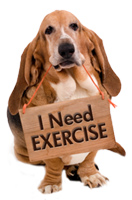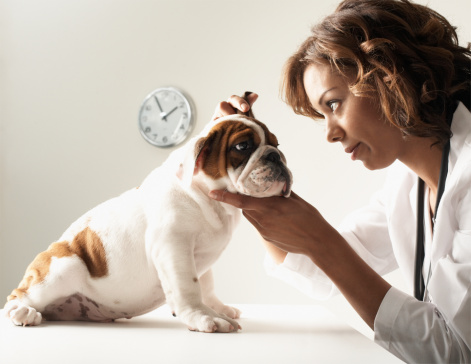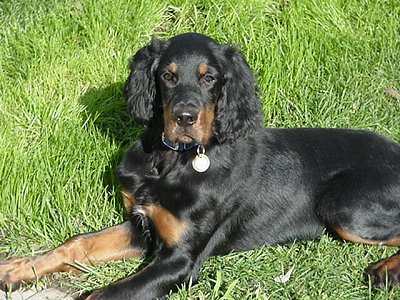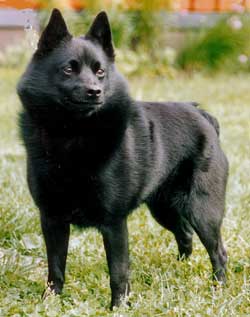Overweight….
 The dog or cat who is overweight is probably starving. She is seeking nutrients from foods that have too little nutritional value, and therefore is eating too much. Commercial pet foods are filled with things an animal doesn’t need—-sugar, salt, waste fillers, chemicals. These same foods lack what is required for animal health—vitamins and minerals, enzymes, proteins, vegetables, grains. Malnutrition and/or malabsorption are important factors in animals and human obesity, as are food allergies and sensitivities. Other factors include glandular malfunction, boredom and habit, lack of exercise, competition for food with other pets and guardians who substitute food for love.
The dog or cat who is overweight is probably starving. She is seeking nutrients from foods that have too little nutritional value, and therefore is eating too much. Commercial pet foods are filled with things an animal doesn’t need—-sugar, salt, waste fillers, chemicals. These same foods lack what is required for animal health—vitamins and minerals, enzymes, proteins, vegetables, grains. Malnutrition and/or malabsorption are important factors in animals and human obesity, as are food allergies and sensitivities. Other factors include glandular malfunction, boredom and habit, lack of exercise, competition for food with other pets and guardians who substitute food for love.
Ear infections…
 Head shaking, pawing or scratching at the ears, odor, brown discharge, and redness or swelling inside the earflap indicate an infection. This may be caused by injury or by foreign bodies in the ear (ticks or plant matter from running through high grass), by bacterial or fungal infections or by mites. Flop-eared dogs are very pronto this ear infection, particularly cocker spaniels. In my dog-grooming days, I don’t think I ever groomed a cocker with healthy ears. Fungus infections inside the ear can be caused by leaving bath water inside them, or from too many treatments with antibiotics. Chronic ear infections that are bacterial or fungal are signs of a reduced immune system and may also come from food allergies
Head shaking, pawing or scratching at the ears, odor, brown discharge, and redness or swelling inside the earflap indicate an infection. This may be caused by injury or by foreign bodies in the ear (ticks or plant matter from running through high grass), by bacterial or fungal infections or by mites. Flop-eared dogs are very pronto this ear infection, particularly cocker spaniels. In my dog-grooming days, I don’t think I ever groomed a cocker with healthy ears. Fungus infections inside the ear can be caused by leaving bath water inside them, or from too many treatments with antibiotics. Chronic ear infections that are bacterial or fungal are signs of a reduced immune system and may also come from food allergies
Bullying…..
Play is apparently highly reinforcing for a great many dogs. The derailing of play by overly rough behaviors therefore serves as a sufficiently rotten consequence to purge it from most dogs’ repertoires. Likewise, play attempts directed at non-consenting dogs fall flat and so also usually diminish in frequency. For some dogs, however, roughness and harassment of non-consenting dogs is quite obviously reinforced. they engage in it all full tilt, with escalating frequency and almost always direct it at designated target dogs. this can be enormously distressing for target dogs, as well as for humans who witness it.
Owner Guarding….
 Dogs may be selectively aggressive when approached most notably approach by other dogs, through people can also be targets, if they are in proximity of their owners or when on leash. Some owners find the “jealous” behavior flattering or amusing, while others are distressed. Owners often attribute the behavior to “protectiveness.” The topography of the behavior is identical to other kinds of resource guarding, and it responds to the same kinds of treatment exercises, so it would seem logical to consider the owner to coveted resource in these cases.
Dogs may be selectively aggressive when approached most notably approach by other dogs, through people can also be targets, if they are in proximity of their owners or when on leash. Some owners find the “jealous” behavior flattering or amusing, while others are distressed. Owners often attribute the behavior to “protectiveness.” The topography of the behavior is identical to other kinds of resource guarding, and it responds to the same kinds of treatment exercises, so it would seem logical to consider the owner to coveted resource in these cases.
Why Does My Dog…?
 It is perfectly normal thing for them to do when they want to give warning and call for assistance. Persistent barking, however, can drive owners and neighbors up the wall. Some breeds are naturally more vociferous than others, so if you are looking for a relatively quiet dog, don’t by one of the guarding breeds. If you do have a guarding breed, don’t give it the run of your garden when you go to work, otherwise you will come to find some irate neighbours brandishing a court order. Having accepted that the basic function of barking is to give warning, a lot of dogs bark for other reasons. The barking as an attention-seeking behaviour; they bark out of excitement; some highly excitable types bark at every little noise, and some dogs bark for the sheer hell of it. If you have a problem barker, it is sensible to try and establish what triggers it off and whether this is the area that you should be controlling.
It is perfectly normal thing for them to do when they want to give warning and call for assistance. Persistent barking, however, can drive owners and neighbors up the wall. Some breeds are naturally more vociferous than others, so if you are looking for a relatively quiet dog, don’t by one of the guarding breeds. If you do have a guarding breed, don’t give it the run of your garden when you go to work, otherwise you will come to find some irate neighbours brandishing a court order. Having accepted that the basic function of barking is to give warning, a lot of dogs bark for other reasons. The barking as an attention-seeking behaviour; they bark out of excitement; some highly excitable types bark at every little noise, and some dogs bark for the sheer hell of it. If you have a problem barker, it is sensible to try and establish what triggers it off and whether this is the area that you should be controlling.
Why Does My Dog…?
Although much recognised in humans, stress is rarely considered as a contributory factor in behavioural changes in dogs. In humans, doctors recognise the fact that stress is a major cause of many physical ans psychological illnesses, yet we are less ready to consider how our dogs cope with the stresses and strains that our modern environment places upon them. We might recognise as fearfulness the fact that some dogs, on being taken into a do club for the first time, will salivate, hold their ears back, tuck their tails between their legs, leave sweaty paw prints on the floor and, in some cased, urinate. Unfortunately, all too often the advice given to the owner is that they will ‘get used to it’. What we don’t recognise is that pro-longed exposure to this fearful environment will drain the dog’ stress reserve level and its ability to cope – much as it does in people.
What to Feed your Gordon Setter
 The Grodon Setter is the only breed of dog called “Setter” originating in Scotland. The Duke of Gordon developed this specific breed at the kennels on his estate. He developed it to be both a working and hunting dog. They herded sheep and pointed to feathered game for sportsmen. This combination was ideal for gentlemen who needed a working do for most of the week and a good hunting companion for the week end.
The Grodon Setter is the only breed of dog called “Setter” originating in Scotland. The Duke of Gordon developed this specific breed at the kennels on his estate. He developed it to be both a working and hunting dog. They herded sheep and pointed to feathered game for sportsmen. This combination was ideal for gentlemen who needed a working do for most of the week and a good hunting companion for the week end.
The Gordon Setter has a special need for a high fat content diet. this need for additional dietary fat is especially high when the setter is working or when it is under stress. Large quantities of water must accompany the additional dietary fat intake during these times. A sure sign that the dog requires additional fat in its dietary intake is a brittle coat. When the Gordon has the proper amount of fat in the diet, its coat is very soft. The best sources of fats for this breed are vegetable or poultry fats. the worst source of fat for the Gordon Setter is beef fat.
The Gordon Setter’s native environment in Scotland provided food sources of potatoes, wheat, corn, and poultry of the wild game variety. Therefore, I recommend a blend of foods that are high in their carbohydrate-to-protein ration as the ideal diet for the Gordon setter, The blend I recommend would contain potatoes, wheat, corn, and poultry. Conversely, I feel the worst blend would be white rice, soy, beef, or horse meat and their by-products.
What to Feed your Affenpinscher
 The Affenpinscher developed in the lowland farm area of Germany prior to the 15th century. It has a facial appearance similar to a monkey, and the literal translation of the German word Affenpinscher is “monkey terrier.” This breed of dog is very quick afoot and at one time earned its keep as an effective stable yard ratter.
The Affenpinscher developed in the lowland farm area of Germany prior to the 15th century. It has a facial appearance similar to a monkey, and the literal translation of the German word Affenpinscher is “monkey terrier.” This breed of dog is very quick afoot and at one time earned its keep as an effective stable yard ratter.
Native food supplies for this breed would have been rodents (rats, mice and other small ground animals), poultry, and farmland grains of wheat, corn and barley or alfalfa with ground vegetables of potatoes, carrots and cabbage.
For the Affenpinscher I recommend commercial foods that are high in their carbohydrate content from potatoes and barley. They meat protein source should be a blend of horse meat and poultry. I also recommend that you avoid feeding any foods containing soy. beet pulp, white rice, fish meal or lamb to an Affenpinscher.
The Miniature Pinscher originated in Germany where its history goes back over many hundreds of years. It was originally a barnyard ratter. It is often called the Reh Pinscher in Germany because its appearance is similar to a native species of miniature deer. They are called the Miniature Pinscher in the U.S.A because their appearance is very similar to a “miniaturized Doberman Pinscher.” However, there is no genetic relationship between these two breeds. The Min Pin is wonderful with children and in a family environment. It is also very territorial and possessive. Therefore, it makes an excellent family watch dog. This breed is small and has a sleek appearance, yet it is very “thick boned.” This characteristic gives it a different requirement for bone building minerals per pound of body weight than other “small” breeds that are more fragile or “thin boned.”
Food supplies from this breed’s native environment would have been sugar beet, potato, cabbage, and meats from pork, venison, and rodents. For the Miniature Pinscher I recommend commercial foods that are a blend of horse meat, beef, wheat, potatoes, yellow corn, and beet pulp. However, you should avoid feeding a commercial dog food that contains any ocean fish, soy, or rice to this breed.
What to Feed your Schipperke
The Schipperke Developed in Flanders before the 12th century. This small lowland country became part of Belgium in 1830. The Schipperke was a barge dog and companion to the boatman who worked the channels of this lowland country for centuries. the name Schipperke in Flemish means ” little boatman.” This breed also served as a ratter and carriage dog in the towns along the channels.
A very active breed of dog, it burns calories at an exceptionally high rate on a per pound basis when compared with many lethargic breeds. Today’s Schipperke is also one of the few breeds that lives an average of 15 to 16 years of age. Such longevity is a very rare to this breed’s efficient utilization of food and to its high activity level, which keeps it in good shape.
Native food supplies for this breed would have consisted of both ocean and fresh water fish, dairy cattle, grains from the barges, beets, and other low ground type vegetables.
for the Schipperke I recommend commercial foods that contain an equal amount of beef blended with fish. The food also should contain wheat, oats yellow corn, and beets. I also feel you should avoid feeding a Schipperke any soy, avocado, white rice, lamb or citrus products.







